#Arthur Evans
Text
Bull-god, drunk god, god of women and transvestites, giver of ecstasy, master of dance, lord of the emotions—such were the various masks worn by the daimon whose lineage went back to ancient Minoan civilization. In his myths and rituals, Dionysos embodied both a feeling for the living continuities of nature and a concept of the human personality as an organism deeply rooted in the nonrational forces of the cosmos. Serving as the focus for the spiritual needs of Greece's underclasses, he became the god that the patriarchal establishment could neither accept nor eliminate. And so Dionysos represented the return of the repressed in several senses: return of the religious needs of the lower classes, return of the demands of the nonrational part of the self, and return of the Minoan feeling for the living unity of nature. And so in turn he threatened several repressors: the aristocracy of well-to-do male citizens, the domination of intellect over emotion, the alienated ethos of the city-state.
Arthur Evans, “The God of Ecstasy: Sex Roles and the Madness of Dionysos,” 1988
712 notes
·
View notes
Text
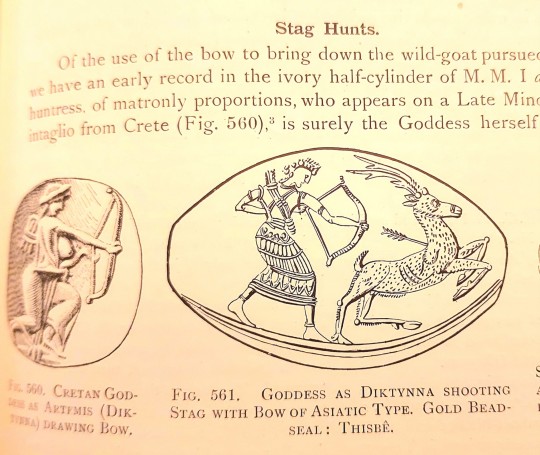
For your perusal and enjoyment; Minoan sealstones from Knossos, seeming to show an Artemis or an Atalanta sort of figure.
Or, well, some completely different lady archer with nice cans motif we don't understand because we can't read Linear A.
This is from an early 1900s copy of Arthur Evans' books on his excavations at Knossos. He's a sucker for incredibly obvious fakes like the Boston snake goddess, and really reaches to see scenes from later Greek myth in seal-stones- but he shows a lot of material that seems to have fallen out of circulation in later books that just seem to summarise each other.
#minoan#mythology#artemis#atalanta#greek mythology#bronze age#knossos#arthur evans#archaeology#ancient civilizations
21 notes
·
View notes
Text
you got your known Minoans and your unknown Minoans (part four)
(reposted, with edits, from Twitter)
(part one, part two, part three on Tumblr)

Where were we? Oh yeah, bagging on Arthur Evans, right?
(You’re going to want to read Parts 1-3, linked above, if you haven’t already or this won’t make much sense.)
Did I mention in this that even though women appear frequently in other types of Minoan art, no composite ivory statuettes that are both definitely female and definitely genuine have been found? Interesting side note. Like the one thing we know about the Minoans is Snake Goddesses, right? Well, that and Bull Jumpers.
It’s hard to overstate the hold Minoan art still has on the Western imagination.

Image: A copy of a translation of the Odyssey, using the Blue Ladies fresco as cover art. Ironic, given that the culture that produced the Odyssey is probably the one that destroyed the Minoans.
Anyway, the problem is there are a ton of these composite ivory Minoan goddess statues floating around, none of them have reliable provenience, and they're what were used to authenticate each other. See the problem?
Some of them are proven forgeries. So a lot of what is "Minoan-looking" in our minds is forgeries, possible forgeries, and "restorations" done by turn-of-the-century artists.
And as we learn more about them, we find out that a lot of the assumptions were very much dictated by Victorian expectations. Those "corsets" or "jackets" Minoan women are depicted as wearing? Actually shifts with skirts tied around them.
There are a lot of problems with the Boston Goddess. She's too skinny, for one. And if, as some have suggested, her hips and butt are so flat because the ivory is significantly worn away, how are the details of her flounces still visible there? The Boston Goddess (or rather, the fragments of her not used in the restoration), the Seattle Boy-God, and the Ashmolean Boy-God have all been carbon tested. The results were intriguing-- 250ish years old for the Ashmolean figure, and 400-500 for the other two. That's deeply weird. Obviously, the ivory is far too new for them to be genuinely Minoan, but it's awfully old for a Victorian forgery.
But in any case, enough about the artifacts themselves. I want to talk about the conclusions Evans drew from them, which have been repeated as fact in a lot of books and textbooks and journals and magazines since.
The Great Goddess and Her Salesman-Priest
Classical goddesses go in and out of fashion. For most of the Renaissance, all the way to the 1800s, writers mentioned Venus and Diana most often, followed by Minerva/Athena and Juno/Hera. Diana was associated primarily with chastity.
In the Romantic era, Venus was still the most popular goddess (although she was now associated with natural surroundings), and Diana was associated with the moon and animals more than chastity. Proserpina/Persephone and Ceres/Demeter also gained prominence (earth/seasons).
So, the Romantics were very much enamored with the idea of Mother Earth/nature as female (go conquest that land in "virgin" America, yo). The concept wasn't new--lots of cultures personify the earth as female--but this was very much a 19th-century European imagining.
Basically a lot of Victorian dudes liked the idea of their porn involving pretty landscapes.
So, along comes a German dude named Friedrich Wilhelm Eduard Gerhard, because everything you say is credible if you're a white dude with four names, who's like "hey maybe all those Greek goddesses were actually ONE goddess, and she was Mother Earth, that tempestuous temptress."
And like as far as I can tell, that was it. That's the Tweet. He had An Idea about how ancient religion might have worked, and everyone nodded sagely and suddenly it was a theory. The Greeks actually believed in one goddess, with a bunch of different faces.
And then, some of those other dudes nodding along sagely to this theory that didn't arise organically from studying the actual writings and artifacts of the time, but from Mother Earth as a concept being trendy in the 1850s, were like, hey, so we know that the Anatolians and Mesopotamians influenced ancient Greek thought, so if the Greeks worshipped a single goddess, the Anatolians and Mesopotamians must have too!
And then they were like, hey, it was probably also true across Europe! Because there's this <checks notes> Swiss judge named JJ who thinks all of human society was once matriarchal and only later evolved into patriarchy so it seems logical that everyone worshipped a goddess.
For those following along at home, no, this is not how logic works, but these dudes were probably drinking a LOT of absinthe.
Goddess Worship Isn’t Love For Women
Now, one might point out, for example, that the ancient Athenians literally had a goddess as their patron deity and still managed to, arguably, utterly despise women more than anyone else in the world at that time, so clearly goddess worship doesn’t automatically equate to matriarchy, but anyway.
But Jessica! (I can hear you saying, o theoretical reader) You're such a shrieking feminist harpy that you put "howling maenad" in your Twitter bio. Why are you objecting to the idea of widespread ancient matriarchy and female-centered monotheism (or duotheism, since there was also a god)?
Well, here's the thing. It's certainly a cool idea. And it even makes a sort of pop-psychology sense. Back in the Stone Age, maybe men hadn't yet figured out that they were involved in the reproductive process and so deferred to women as life-givers.
But that sort of thinking can lead us to dismiss or ignore real history. Women have always led, women have always fought, women have always ruled, and that shouldn't be manwashed away. But that doesn't mean it was normative. And it matters--both for truthfulness and to fully appreciate what the women who managed to lead actually accomplished--if it wasn't normative. It can also make us miss that matriarchy--*real* matriarchy--isn't necessarily the mirror of patriarchy.
When I was in college, in one of my anthropology classes, we had a textbook that said that there was no such thing as matriarchy, except as a theoretical concept. There was matrilineality, and matrilocality, but not matriarchy.
Was it true? Well, here's the thing: if you define matriarchy as we define patriarchy, but just replace "men" with "women" in the description, arguably it is true that matriarchy doesn't exist. To the best of my knowledge, no one’s found evidence of societies where women treat men like men treat women in patriarchal societies.
But there are, and have been, societies where women own the property, societies in which elder women are the primary leaders/authorities, etc. But they don't attempt to exert control over men in the same way men do over women in a lot of patriarchal societies. So it becomes largely a semantic argument. If it isn't an exact analogue to patriarchy, is it matriarchy? Honestly, I've ceased caring all that much about the terminology, and am more interested in how leadership and authority function in those societies.
But anyway, the Romantics weren't feminists. Just because you like the idea of the feminine as emotional and intuitive and nature-y doesn't mean you give a shit about actual women. And as the Victorian Angel In The House would show us, every pedestal has a cage atop it.
The Romantics might profess to revere Mother Nature, but at the end of the day, they revered her as an object: there to be conquered if they wanted to feel manly, there to challenge them if they wanted to feel manly in a different way, there to soothe and inspire them as Muse, and even there to kill them if they were into the idea of la petite mort being la grand mort.

Image: Just a dude really into being penetrated... with arrows.
And Bachofen, our pal JJ the Swiss judge who also had Theories about anthropology, considered humanity's "Demetrian" matriarchal stage just a necessary transitional period on its way to "Apolline" patriarchy, the pinnacle of human evolution.
They dug up a lot of Venus of Willendorf-like figurines (lots of male-looking and animal ones too, but those didn't fit the theory and got ignored) and decided that they represented a single prehistoric Mother Goddess, source of fertility.
I mean here's the thing: when archaeologists find something and they don't know what it is or what it's used for, a popular default category is "ritual object." If you then start forming theories about how religion worked based on your collection of ritual objects, well, you can imagine how that goes.
So this is the milieu into which Arthur Evans was to release his Minoan discoveries. He writes a lot about the "Great Minoan Goddess" and "the matriarchal stage of society, to which the Minoan religious system owes its origin."
I Regret to Introduce You To Jane Harrison...
So along comes Jane Harrison, who is all into JJ's theory about ancient matriarchy as the fullest collection of "ancient facts"--poof! the theory has become fact--and was also very into the idea that all goddesses are actually a single Great Goddess.
If you don't know anything about Jane Harrison, you might be thinking, "oh, good! at last, a woman weighing in on ancient matriarchy. Perhaps we'll get a take that isn't so... patriarchal.”
Allow me to introduce you to Jane Harrison:
"Matriarchy gave women a false sense of magical prestige. With patriarchy came inevitably the facing of a real fact, the fact of the greater natural weakness of women. Man is the stronger, and when he outgrew his belief in the magical potency of woman, proceeded by a pardonable practical logic to despise and enslave her."
...And All These Other Assholes
Another member of these circles was Sir James George Frazer (only three names there, but also has a "Sir" so probably as credible as the four-name dude). Remember him? The Golden Bough? Yeah.
He looooved the idea of a single Great Mother Goddess and attempted to collect and catalogue world myth and folktales and wanted to trace her and her ever-dying younger consort as a universal or near-universal archetype in human consciousness.
You want Joseph Campbells? This is how you get Joseph Campbells. But Joseph Campbell is a rant for another time.
Carl Jung and Marija Gimbutas, incidentally, thought along similar lines and considered it a universal archetype present in all human psyches, and all cultures.
No writing or art about it from a particular culture? No evidence that it’s actually a thing? *hand wave* Whatever.
Part of what was animating all this thought was confidence that human culture was evolutionary--that there was a relatively smooth line of human progress from a primitive past to an enlightened present to a utopian future.
I mean, the Bronze Age collapse might beg to differ. But what do I know? I'm not a white dude with four names and or a "Sir".
Incidentally, this Victorian confidence that human civilization is smoothly evolutionary appears to be literally killing us right now but let's pretend this is all fun archaeology stuff to mute the silent internal screaming.
Oh Wait, I Forgot To Tell You About The Cat
Anyway. All of these assumptions very much influenced how Evans interpreted what he found, and presented it to the public. Female snake handlers, for example, are actually pretty rare in Minoan art (maybe even all forged), but you wouldn't know that from textbooks about it.
It affected how he arranged the things he found when attempting to recreate altar assemblages.
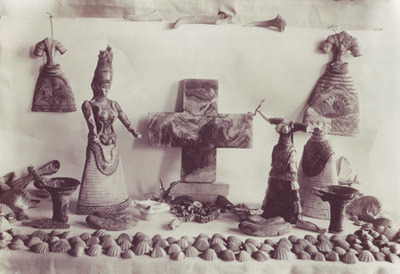
That cross in the assemblage above? They found that and decided that it MUST have religious significance and be the centerpiece of an altar... ...because Christianity, basically.
You know that famous Snake Goddess figurine?
The faience one that isn't a suspected complete fake? You've probably seen her. You can buy earrings of her on Etsy.

That cat on her head?
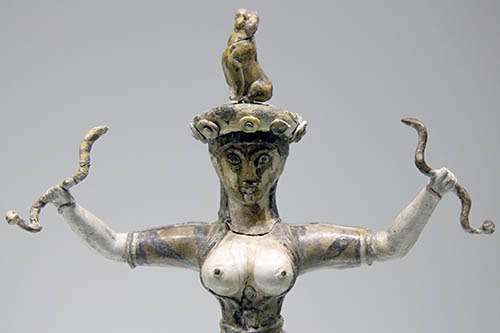
Yeah, it's a random cat that they found elsewhere and decided to stick on her head.
...because the Anatolian and Mesopotamian goddesses they liked to use as proof of a universal singular Great Mother Goddess were often pictured with lions.
So, you know: cat-hat.
About Those Snakes...
So anyway, snake-handling female figures were actually a relatively rare find in Minoan art, but Evans decided she was their central deity, a manifestation of the Great Mother Goddess whose primary attribute was fertility.
But here's the thing: we don't have any writings we can read from the Minoans. All we have is visuals (mostly "restored" by Victorian artists), and we don't *know* what any of their symbolism meant to them. And even a lot of the visuals aren't helpful.
We know that depicting women with bared breasts (not topless, with a garment framing them, which seems very deliberate) was a thing. We don't know what that means. We don't know if this was reflective of *actual clothes that women wore* or whether it's symbolic (like Artemis wearing a crescent moon in her hair). We don't know what breasts meant, in their visual language.
Minoan art doesn't depict children very often, and doesn't depict nursing mothers at all (unlike Egyptian or mainland Greek art). So do breasts represent fertility in their visual vocabulary? No idea.
Are bared breasts considered erotic? Again, no idea. That assumption was strongly tied to the snakes, which are tied to Christian associations of snakes with sexuality--specifically sexual sin. If the bared-breasts women were actually even originally depicted with snakes.
Ultimately, we don't even know if the statue of a snake-handling woman represents a goddess, a priestess, or a woman representing or symbolizing something else entirely. Frankly, we don't even know what her face actually looked like.
Despite various authors rhapsodizing about the "sternness of her expression" and whatever else, the entire face of this famous statue, and her snakes, were fashioned by Halvor Bagge, a restorer/artist. She might have been holding sheaves of grain, for instance. She might have been smiling gently. She might have looked afraid. We don't know.
We know very little.
Who Better To Say What We Want than Those Who Can’t Speak?
Because the Minoans didn't leave behind any writing we can read, and most of the art we have from them had to be heavily restored by Victorian artists, they provided a perfect blank slate for Victorian men desperate to prove European superiority to project onto.
Now. Archaeologists *aren't* just people who dig up old stuff. Interpreting the past is something we have to do if we want to try to understand it. And there's nothing wrong with putting forth theories. But it becomes a problem when it's not made clear that these are theories, when theories are built upon theories upon theories upon theories, with no clear substantiation for any of it. Theory slides into "fact" very easily.
And it can very easily become circular. Evans used theories about other cultures worshipping a single Great Goddess to guide what he looked for on Crete and how to present what he found, which has looped around to Crete being the center of Great Goddess worship and being used to substantiate the idea of singular Great Goddess worship in some of the same cultures whose practices were used to suggest that Crete might be like they were. Much like ivory statuettes with no provenience were used to substantiate others.
And all of that is then used as evidence of How Human Culture Works. So suddenly The Center Of Ancient Mediterranean Worship is safely in Europe.
When, as far as what can actually be verified, what doesn't come out of the airy, tempestuous realms of Romantic theory, is almost nothing.
We still don't know the Minoans.
Fin.
#archaeology#arthur evans#crete#white supremacist archaeology#snake goddess#art forgery#minoan art#matriarchy#goddess worship#the great goddess#romanticism#minoan#minoans
97 notes
·
View notes
Text
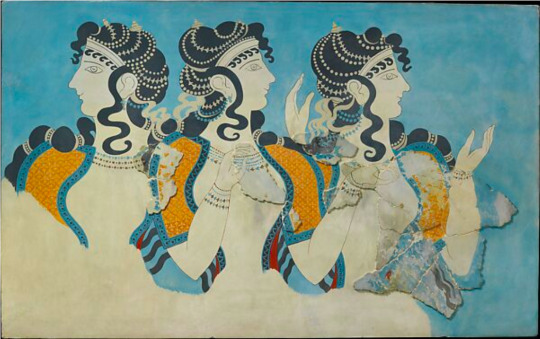
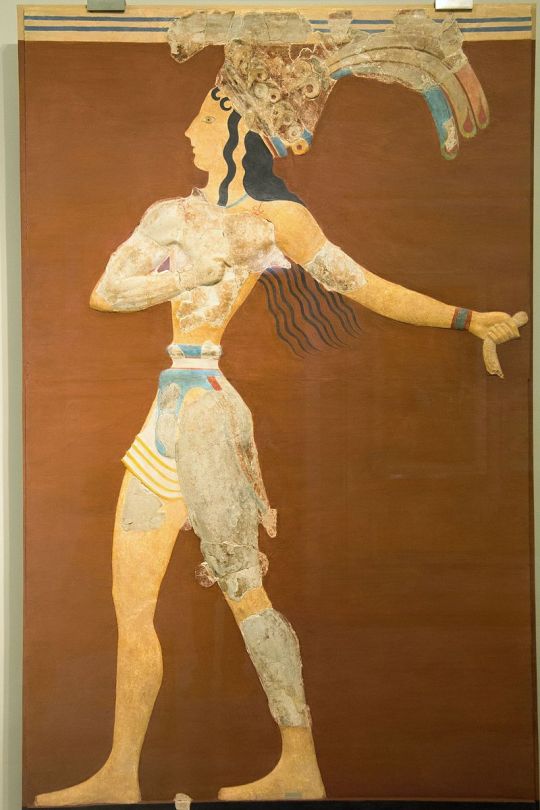

Émile Gilliéron (CH, 1850 - 1924)
Ladies in Blue fresco, Reproduction
The Prince of the Lilies, or the Lily Prince or Priest-King Fresco
The Knossos throne room (supposedly Minos')
This group of three women was originally restored by E. Gillieron (father) on the basis of other fragments of frescos. The facial outline of the "Cup-bearer" fresco supplied the model for the faces of the "Ladies in Blue". Excavated before 1914, Knossos.
The Prince of the Lily was assembled using various frescoes (Evans demanded results to impress and keep fund-raising)
Gilliérons (father & son) relocated to Athens, in 1877, where they produced archaeological illustrations for Greek and foreign excavators, designed commemorative postage stamps for the inaugural Olympic Games (1896 and 1906), and served as an art tutor for the royal family of George I.
Gilliéron worked for Heinrich Schliemann and gained a reputation as the best archaeological illustrator working in Greece at the time.
He became the chief restorer for Arthur Evans at the Knossos Palace. For over three decades, Gilliéron worked with his son, and successor, also named Émile, creating reproductions of frescoes and other artifacts.
Greece, before and after its liberation struggle, was a playground for archeologists/treasure hunters. Following Evans' discoveries, a "Cretan fever" spread over the Western world, thus creating a huge market for official copies, smuggled originals and forgeries. Gilliérons' prices skyrocketed.
An Odyssey History Documentaries 2022 production with the misleading clickbait title "Was Europe's First Advanced Civilization Faked? | The Secret of the Phaistos Code" is exposing the early ambiguous archeological approach, historical background and Gilliéron's talent to recreate free of accuracy illustrations and restorations, i.a.
https://www.metmuseum.org/art/collection/search/258137
https://en.wikipedia.org/wiki/%C3%89mile_Gilli%C3%A9ron
https://en.wikipedia.org/wiki/Prince_of_the_Lilies
https://mymodernmet.com/minoan-palace-of-knossos-crete/
https://www.youtube.com/watch?v=Phohy3fEq7U
18 notes
·
View notes
Text
fuck arthur evans all my homies hate arthur evans
#classical art#minoans#ancient history#isle of crete#crete#ancient greece#world history#art history#art#art meme#art memes#arthur evans#archaeology
5 notes
·
View notes
Text
Ok something I did not expect learn is that Arthur Evans was actually based??
Left wing anti-imperialist who was arrested for his criticism of the Ottoman empire, agreed not to export any artefacts from Crete*, and declared he would not excavate until Crete was free. He then began funding rebels fighting for independence from the Ottomans.
What an absolute fucking Chad
4 notes
·
View notes
Text
1878 - Knossos is uncovered by Μίνως Καλοκαιρινός* - Crete
* Kalokairinos (left), further excavated in 1894 by Arthur Evans (right)

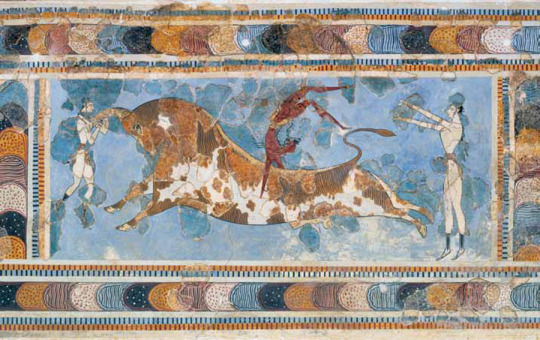
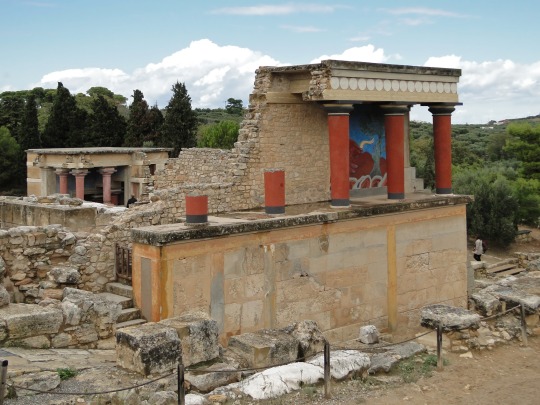
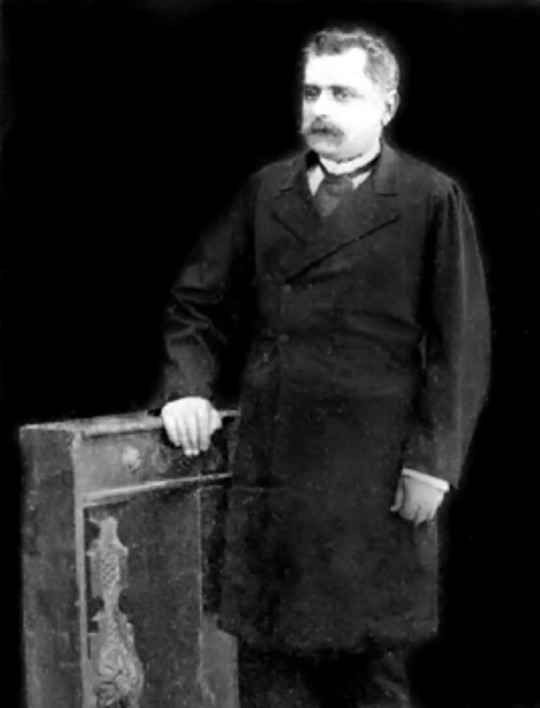

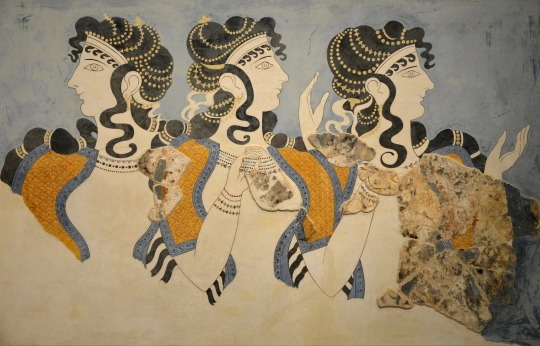



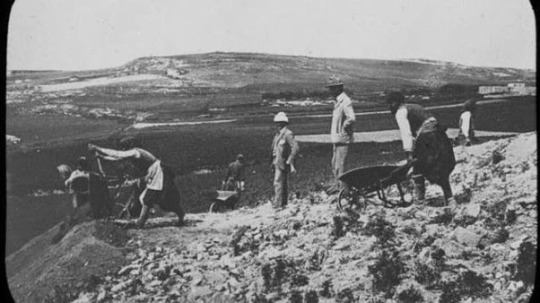
An aesthetic history of Eastern Mediterranean archaeology
6/?
“The visitor coming to Knossos can see on the left side piles of unworked stones with mortar; there were many such piles arranged in two rows, clearly of Roman date, and tradition calls them 'Royal'. These structures were demolished by Ottoman soldiers and their material, especially the white stone (marble), was used for the building of the barracks of Herakleio”
Minos Kalokairinos
#knossos#an aesthetic history of eastern mediterranean archaeology#archaeology#Crete#minos kalokairinos#Arthur Evans#art of archaeologists#frescoes#ancient color#Minoan Art#Knossos palace
7 notes
·
View notes
Text
"Gays who have as yet no sense of gay pride see a zap on television or read about it in the press. First they are vaguely disturbed at the demonstrators for rocking the boat; eventually, when they see how the straight establishment responds, they feel anger. This anger gradually focuses on the heterosexual oppressors, and the gays develop a sense of class-consciousness."
-Arthur Evans, leader of the Gay Activist Alliance quoted in Up from invisibility
#I admit when a trans person does something that annoys me they just annoy me but when a cis person says they find the trans person annoying#i do get angry#arthur evans#larry gross#grad school life#queer activism#gay activism#gay history
4 notes
·
View notes
Text
"El militarismo norteamericano ha afectado al modo en que los americanos ven la masculinidad, exactamente como el militarismo romano afectó a las opiniones de los romanos. Todos los hombres ame- ricanos han sido condicionados a lo largo de su vida para pensar en la agresividad disciplinada como algo masculino, a mirar por encima del hombro el afemi- namiento, el sentido de la diversión, la pasividad, y una emotividad abierta; a admirar la dureza en otros hombres, a sentirse intimidados por todo aquello a lo que se cuelgue la etiqueta de “propio de nenazas”; a disfrutar de relaciones de dominación y obediencia, a deleitarse de emoción al ver cómo se inflinge dolor en los demás; a ponerse cachondos con los uniformes; y a ser capaces de sentirse cómodos funcionando dentro de grandes, impersonales y jerárquicas instituciones. La sociedad americana considera a los hombres que interiorizan estos valores dotados de una salud men- tal admirable. Pero este es el concepto de salud men- tal que sustenta la guerra. Cuando llegan las órdenes, estos saludables hombres están listos para matar a otros hombres al dictado. Están totalmente faltos de preparación para relacionarse con otros hombres de una manera abiertamente amorosa, cálida y sexual. Para ellos, eso es de locos. Hasta hace muy poco, la mayoría de los psiquiatras estaban de acuerdo con esa idea."
– Arthur Evans
0 notes
Text

Today's photo with the most hits: the Knossos procession fresco.
0 notes
Text
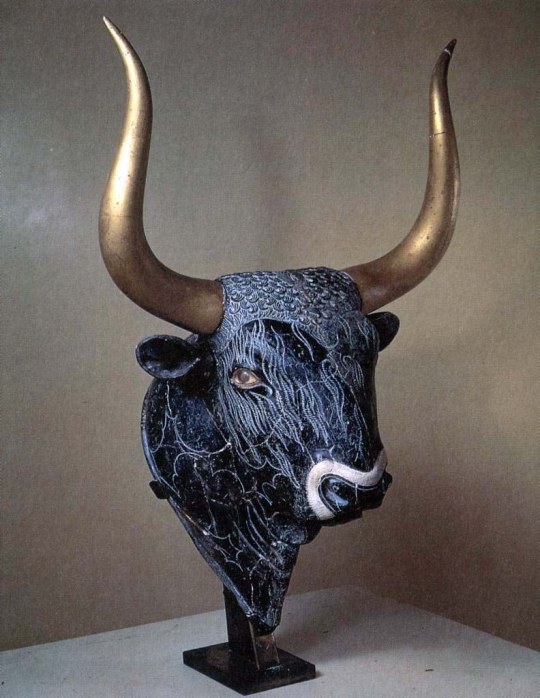
Quest'opera è un vaso da libagioni a forma di testa di toro risalente al 1550-1500 a.C., ritrovato da Arthur Evans a Cnosso e conservato oggi al Museo Archeologico Nazionale di Iraklion. Questo vaso minoico è l'ennesimo esempio di restauro di sir Arthur Evans che ha eseguito un invasivo restauro sulle corna e alcuni pezzi mancanti mai ritrovati, la parte originale è quella sinistra. Gli occhi sono di cristallo di rocca e il muso è di madreperla.
0 notes
Text
In the rites of Dionysos during classical times, there were indeed cases where men and women celebrated the god in sexually separated groups and with different kinds of rites. But there were also occasions where the sexes acted together, even in maenadism. In the latter case, male participants were few and apparently always feminine-identified. Originally, in the prehistoric past, maenadism may very well have been an all-woman affair, but by the time of the classical era instances of male participants were not unknown. […] The striking feature about male participation in maenadism is that in order to be acceptable men had to lay aside all signs of male privilege and adopt a feminine persona.
Arthur Evans, "The God of Ecstasy: Sex Roles and the Madness of Dionysos," 1988
#Dionysos#gender#queer#trans#-ish#maenads#bacchants#Arthur Evans#books#genderfuckery#masculinity#femininity#anyway femmes to the front
151 notes
·
View notes
Text
Stuff I've Been Reading: November 2023
Happy December, y’all. I can’t believe it’s almost the end of 2023.
For November’s SIBR, there is, as usual, tons of anti-colonial literature, both fiction and nonfiction. There’s also an indie feature, something I am hoping to incorporate more and more into my future posts in order to help uplift and support my fellow indie/small press authors.
Fortunately, just about every book this month was…

View On WordPress
#ancillary justice#ann lecki#arthur evans#book reviews#books#frantz fanon#giovanni&039;s room#james baldwin#reading#t.l. bodine#the darkness of dreamland#the lathe of heaven#ursula k le guin#witchcraft and the gay counterculture#wretched of the earth
0 notes
Text
you got your known Minoans and your unknown Minoans (part one)
(reposted, with edits, from Twitter)

Image: The famous “Ladies in Blue” Minoan fresco.
I’ve been thinking a lot about the Minoans. Everyone loves the Minoans, right?
(If you love the Minoans, you are not going to love this series of posts.)
Part One: The Case of the Very Victorian Goddess
Let’s start with a description of the pop culture perception of the Minoans: a peaceful ancient Greek culture with sophisticated, surprisingly modernist art, and extremely sophisticated technology like running water, who were lovers of beauty and peace.
So, I read Mysteries of the Snake Goddess: Art, Desire, and the Forging of History by Kenneth Lapatin. The author focuses on the (now, I believe, pretty thoroughly debunked) Boston Goddess, a supposedly Minoan ivory figurine of a snake-handling woman. She was an absolute SENSATION when she was first displayed.

Image: The Boston Goddess
Sir Arthur Evans, the most famous archaeologist of the Minoan civilization, dubbed her the "Minoan ambassadress to the New World." She made a 1967 issue of Mademoiselle's list of "art sensations" alongside Rembrandt, Picasso, and Rodin. The Museum's monthly bulletin for Dec 1914 proclaimed her an icon of a "wonderful prehistoric civilization which, after having lain submerged, like the lost Atlantis, for three thousand years, has been brought to light again..."
A comparison to Atlantis here is telling.
Victorian "race science" and Victorian occultism were inextricably linked, the latter demonstrating a passion for interpreting the myths of non-European cultures to reflect the ideas of the former. (Its descendants live on as Ancient Aliens theories, etc.) As archaeology became more popular and contact with ancient, sophisticated, and enduring civilizations such as those in India and China increased, white Europeans (especially the Brits) and Americans started to get uncomfortable.
So they started coming up with theories that hey, those people in the East who built all that amazing stuff, who were the "cradle of civilization," who invented the alphabet? They must have been taught by an even OLDER white civilization, now lost.

Image: The Palace of Atlantis by Lloyd K. Townsend, late 19th century, everyone is very Nordic-looking.
Hence the passion for stories about Atlantis and other lost continents. It just couldn't be true that those non-Europeans were building bigger, more sophisticated civilizations long before most (northern) European civilizations built recognizable cities at all.
That longing for proof of ancient European cultural superiority was in the air when excavations of Minoan sites began.
We must have The Oldest Masters
Now, back to the Boston Goddess. Lacey Caskey, writing for the museum, noted that the statuette's distinctive posture "seems not to have been an artistic convention, but a feature of the actual appearance of this aristocratic race."
This aristocratic race. Oof.
Lapatin observes, in the book, that "Minoan civilization was all the rage, for it seemed to provide Europeans with not only the roots of the ‘Golden Age of Greece,’ long considered the foundation of Western culture, but also a sophisticated early society in its own right, a rival to the 'Oriental' cultures of ancient Egypt and Mesopotamia--known as the cradle of civilization..."
Victorian occultists, of course, tended to claim that their practices were derived from ancient Egyptian or Chaldean rituals. And again, even as they attempted to partake of the antiquity and sophistication of those cultures, they were also trying to prove that white people, or at least divine beings (rather than non-Europeans), built them. (It's always been a bit ironic to me that the Victorians clung to the idea of the superiority of Greece and Rome as the foundation for their ideas of the superiority of white people, while considering contemporary Greeks and Italians not fully white, but I digress.)
And lest you think that I'm hammering too hard on this point, some of the most prominent descriptions of Evans' finds praised the Minoan frescoes as "the Oldest Masters," and his work as proving the culture "bid fair rival to those of the Orient, and to give European Civilization an undreamed of antiquity."
It's hard to overstate the degree to which the archaeological motivation here was European insecurity.
High-Bred Beauty (and I Am Not, Alas, Describing a Horse)
And why was the Boston Goddess herself such a sensation? Her "exquisite characterization of fragile beauty," her "delicate, high-bred beauty." She is "demure," and "full of resolute charm." Professor Ernest Gardner, at Yale, described her head as "recall[ing] rather the sculptures of Gothic cathedrals of the thirteenth centuries."
Or, to be more explicit and just say the quiet part out loud, her face has also been described as "Anglo-Saxon," "European-looking," "Victorian," "Edwardian," and "Parisienne."
To understand what they’re talking about, let’s do a little compare and contrast. Here are some examples of faces from figurines that, to the best of our knowledge, are actually from Crete c. 1500-1200 BCE.


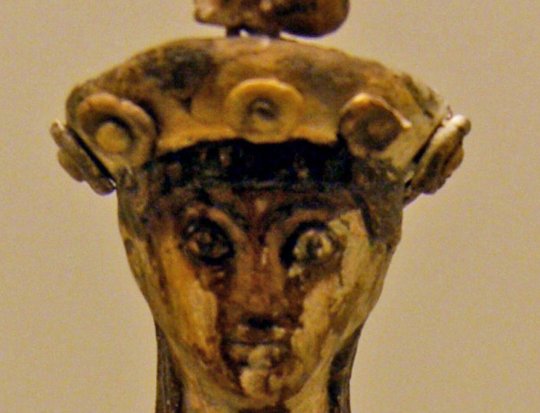
And here’s a close-up of the Boston Goddess’s face:
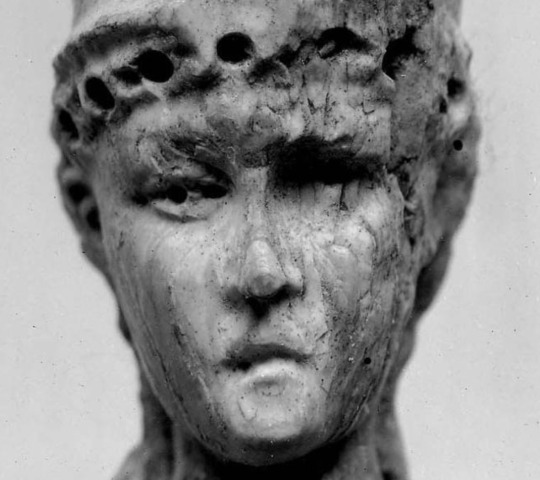
And here’s the face of a now-probably-debunked “Minoan” goddess at the Royal Ontario Museum (read more about her here):
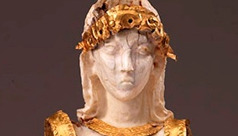
To cut to the chase, eventually they did radiocarbon testing on the Boston Goddess, and the ivory was found to date from between 1420 and 1635 CE. (Not BCE. CE. As in the Renaissance.) A similar figurine, the Seattle Boy God, is made from ivory that's about 500 years old. That in itself is pretty fascinating! They were using old ivory for the forgeries.
What do these proven and suspected fakes have in common? Well, among other things, their very Victorian facial features: inset eyes, small pouty mouths, delicate noses.
Spoiler for where I’m going with this: There are reasons why the Minoans were such an archeological craze, and those reasons are highly political. Because of the ways in which a very specific agenda shaped it, fakes that showed people what they wanted to see were accepted as real (and in some cases, are still sort of accepted as real), and we can't trust a lot of what we supposedly "know."
In Part 2: Bagging On Sir Arthur Evans Forever.
#archaeology#atlantis#minos#crete#minoans#arthur evans#white supremacist archaeology#snake goddess#art forgery#minoan
65 notes
·
View notes
Text
i am going to obsess over this male character in a way that is so lesbian
#will graham#kendall roy#mac mcdonald#dennis reynolds#charlie kelly#eddie diaz#louis de pointe du lac#evan buckley#lestat de lioncourt#hannibal lecter#roman roy#chuuya nakahara#geto suguru#dean winchester#remus lupin#sirius black#abed nadir#iasip#arthur pendragon#james wilson#gregory house#tamaki suoh#dick grayson#andrew minyard#ronan lynch#aaron hotchner#sokka#zuko#wallace wells#lesbian
1K notes
·
View notes
Text










I love you so let's fucking do this.
2K notes
·
View notes